Numerical Research of the Modification of the Combustion System in the OP 650 Boiler
Abstract
:1. Introduction
2. Boundary Conditions and Modeling Description
2.1. Boundary Conditions
2.2. Modeling Description
- -
- changes the swirl directions of individual burners occurred (9 cases),
- -
- changes of air distribution in the upper and lower OFA nozzles occurred (4 cases).
3. Results and Discussion
3.1. Model Verification
3.2. Results of Modification of the Combustion System
4. Conclusions
Funding
Acknowledgments
Conflicts of Interest
References
- European Parliament and of the Council. Industrial Emissions. In Integrated Pollution Prevention and Control; 2010/75/EU; European Parliament and of the Council: Brussels, Belgium, 2010. [Google Scholar]
- Best Available Techniques Reference Document for the Large Combustion Plants; Final Draft; European Commission: Brussels, Belgium, 2016.
- Torresi, M.; Fornarelli, F.; Fortunato, B.; Camporeale, S.M.; Saponaro, A. Assessment against Experiments of Devolatilization and Char Burnout Models for the Simulation of an Aerodynamically Staged Swirled Low-NOx Pulverized Coal Burner. Energies 2017, 10, 66. [Google Scholar] [CrossRef] [Green Version]
- Jo, H.; Kang, K.; Park, J.; Ryu, C.; Ahn, H.; Go, Y. Optimization of Air Distribution to Reduce NOx Emission and Unburned Carbon for the Retrofit of a 500 MWe Tangential-Firing Coal Boiler. Energies 2019, 12, 3281. [Google Scholar] [CrossRef] [Green Version]
- Hwang, M.; Kim, S.; Kim, G.; Lee, B.; Song, J.; Park, M.; Jeon, C. Simulation studies on direct ash recycling and reburning technology in a tangentially fired 500 MW pulverized coal boiler. Fuel 2013, 114, 78–87. [Google Scholar] [CrossRef]
- Chen, S.; He, B.; He, D.; Cao, Y.; Ding, G.; Liu, X.; Duan, Z.; Zhang, X.; Song, J.; Li, X. Numerical investigations on different tangential arrangements of burners for a 600 MW utility boiler. Energy 2017, 122, 287–300. [Google Scholar] [CrossRef]
- Biedermann, F.; Brunner, T.; Obernberger, I.; Sippula, O.; Boman, C.; Ohman, M.; Bafer, L. Summary and Evaluation of Existing Data on Air Staging Strategies—Project ERA-NET “Future BioTex” Report. 2010. Available online: https://futurebiotec.bioenergy2020.eu/files/FutureBioTec-Summary%20and%20Evaluation%20of%20Air%20Staging%20Strategies.pdf (accessed on 6 February 2020).
- Yang, W.; Wang, B.; Lei, S.; Wang, K.; Chen, T.; Song, Z.; Ma, C.; Zhou, Y.; Sun, L. Combustion optimization and NOx reduction of a 600 MWe down-fired boiler by rearrangement of swirl burner and introduction of separated over-fire air. J. Clean. Prod. 2019, 210, 1120–1130. [Google Scholar] [CrossRef]
- Stupar, G.; Tucaković, D.; Żivanović, T.; Stevanović, Ž.; Belośević, S. Predicting effects of air staging application on existing coal-fired power steam boiler. Appl. Therm. Eng. 2019, 149, 665–677. [Google Scholar] [CrossRef]
- Ma, L.; Fang, Q.; Tan, P.; Zhang, C.; Chen, G.; Lv, D.; Duan, X.; Chen, Y. Effect of the separated overfire air location on the combustion optimization and NOxreduction of a 600 MWeFW down-firedutility boiler with a novel combustion system. Appl. Energy 2016, 180, 104–115. [Google Scholar] [CrossRef]
- Laubscher, R.; Rousseau, P. Numerical investigation into the effect of burner swirl direction on furnace and superheater heat absorption for a 620 MWe opposing wall-fired pulverized coal boiler. Int. J. Heat Mass Transf. 2019, 137, 506–522. [Google Scholar] [CrossRef]
- Pronobis, M. Modernization of Power Boilers; WNT: Warszawa, Poland, 2013. [Google Scholar]
- Grądziel, S. Modeling of Flow-Thermal Phenomena Occurring in a Power Boiler Evaporator with Natural Circulation; PK: Kraków, Poland, 2012. [Google Scholar]
- Hernik, B.; Pronobis, M. A zero-dimensional model used as a basis for numerical modelling of OP-650 boiler. Arch. Energy 2012, 42, 17–26. [Google Scholar]
- Shih, T.H.; Liou, W.; Shabbir, A.; Yang, Z.; Zhu, J. A new k-ε eddy-viscosity model for high Reynolds number turbulent flows—Model development and validation. Comput. Fluids 1995, 24, 227–238. [Google Scholar] [CrossRef]
- Badzioch, T.; Hawksley, P. Kinetics of thermal decomposition of pulverized coal particles. Ind. Eng. Chem. Process Des. Dev. 1970, 9, 521–530. [Google Scholar] [CrossRef]
- Baum, M.; Street, P. Predicting the Combustion Behavior of Coal Particles. Combust. Sci. Technol. 1971, 3, 231–243. [Google Scholar] [CrossRef]
- Field, M. Rate of combustion of size-graded fractions of char from a low rank coal between 1200 K–2000 K. Combust. Flame 1969, 13, 237–252. [Google Scholar] [CrossRef]
- Zel’dovich, Y.B. The Oxidation of Nitrogen in Combustion Explosions. J. Acta Physicochim. 1946, 21, 577–628. [Google Scholar]
- Lavoie, G.A.; Heywood, J.B.; Keck, J.C. Experimental and Theoretical Study of Nitric Oxide Formation in Internal Combustion Engines. Combust. Sci. Technol. 1970, 1, 313–326. [Google Scholar] [CrossRef]
- Fenimore, C.P.; Jones, G.W. The water catalysed oxidation of carbon monoxide by oxygen at high temperatures. J. Phys. Chem. 1957, 61, 651–654. [Google Scholar] [CrossRef]
- Fenimore, C.P. Formation of Nitric Oxide in Premixed Hydrocarbon Flames. In Symposium (International) on Combustion; Combustion Institute: New York, NY, USA, 1971; Volume 13, pp. 373–380. [Google Scholar]
- Westenberg, A.A. Kinetics of NO and CO in lean, premixed hydrocarbon-air flames. Comb. Sci. Technol. 1971, 4, 59. [Google Scholar] [CrossRef]
- Westbrook, C.; Dryer, F. Chemical Kinetic Modelling of Hydrocarbon Combustion. Prog. Energy Comb. Sci. 1984, 10, 1–57. [Google Scholar] [CrossRef]
- Baulch, D.L.; Cobos, C.; Cox, R.A.; Esser, C.; Frank, P.; Just, T.; Kerr, J.A.; Pilling, M.J.; Troe, J.; Walker, R.W.; et al. Evaluated Kinetic Data for Combustion Modelling. J. Phys. Chem. Ref. Data 1992, 21, 411–734. [Google Scholar] [CrossRef] [Green Version]
- Lockwood, F.C.; Romo-Millanes, C.A. Mathematical Modelling of Fuel—NO Emissions From PF Burners. J. Int. Energy 1992, 65, 144–152. [Google Scholar]
- Winter, F.; Wartha, C.; Loffler, G.; Hofbauer, H. The NO and N2O Formation Mechanism During Devolatilization and Char Combustion Under Fluidized Bed Conditions. In Symposium (International) on Combustion; Elsevier: Amsterdam, The Netherlands, 1996; Volume 26, pp. 3325–3334. [Google Scholar]

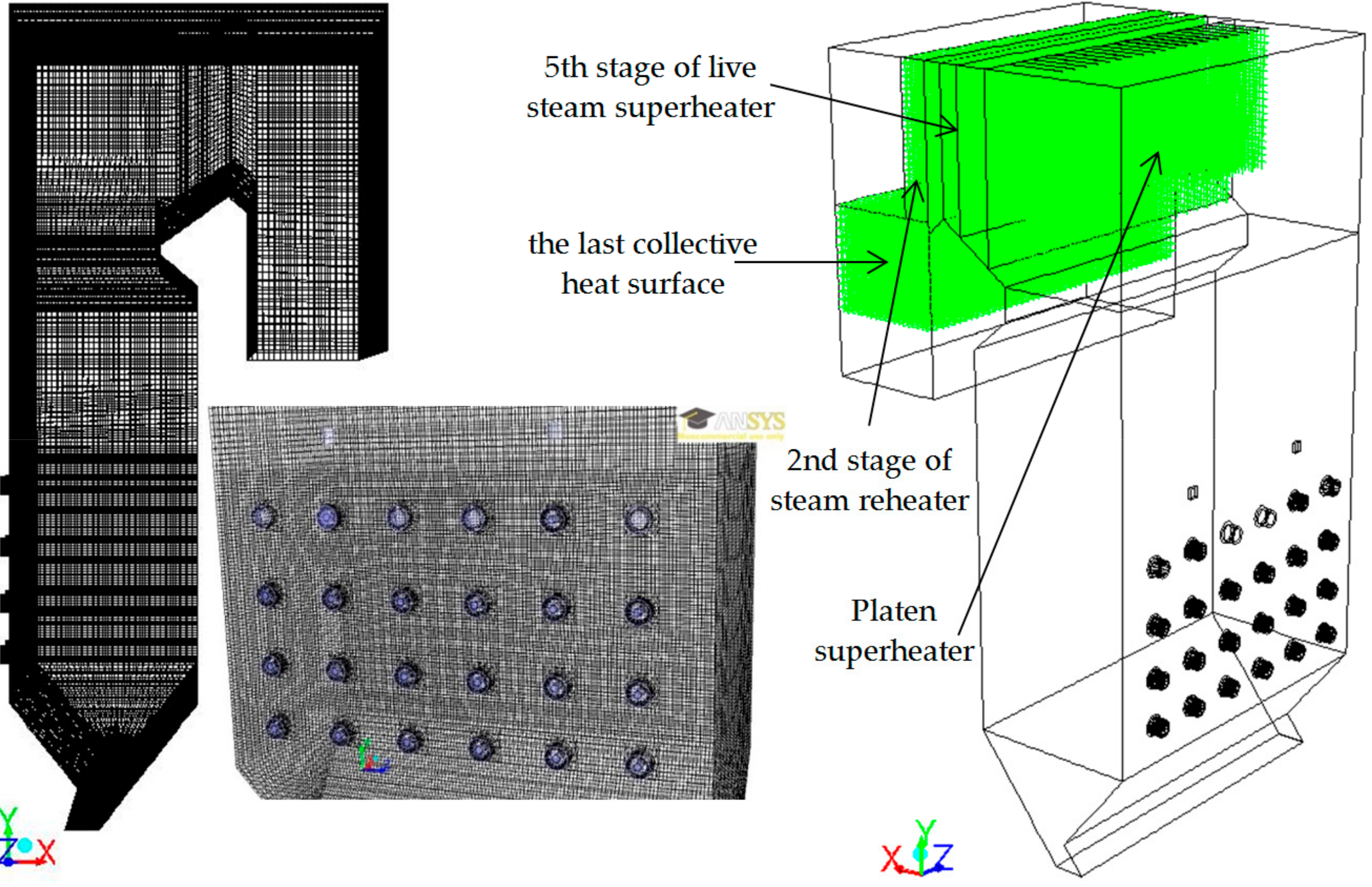
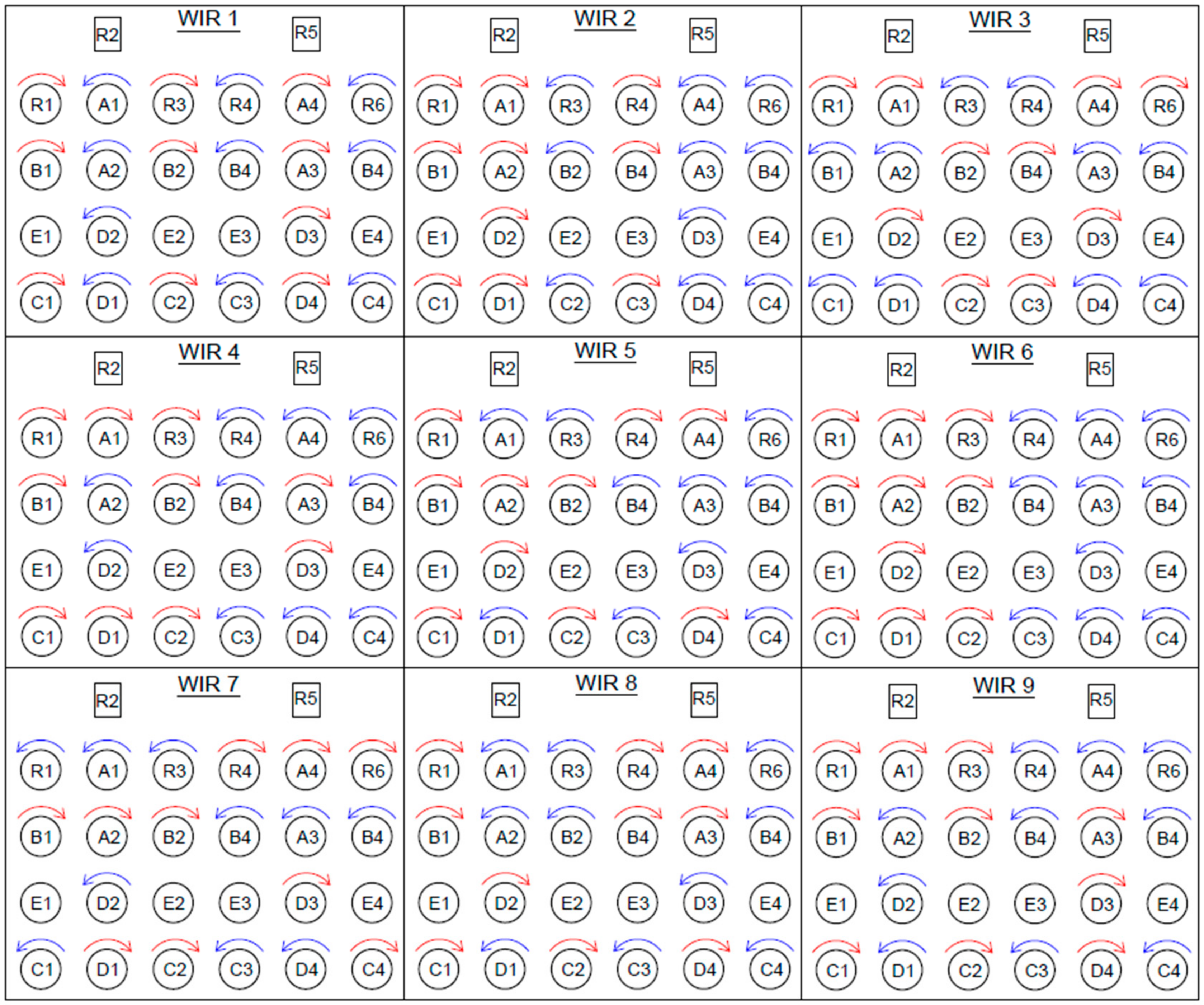
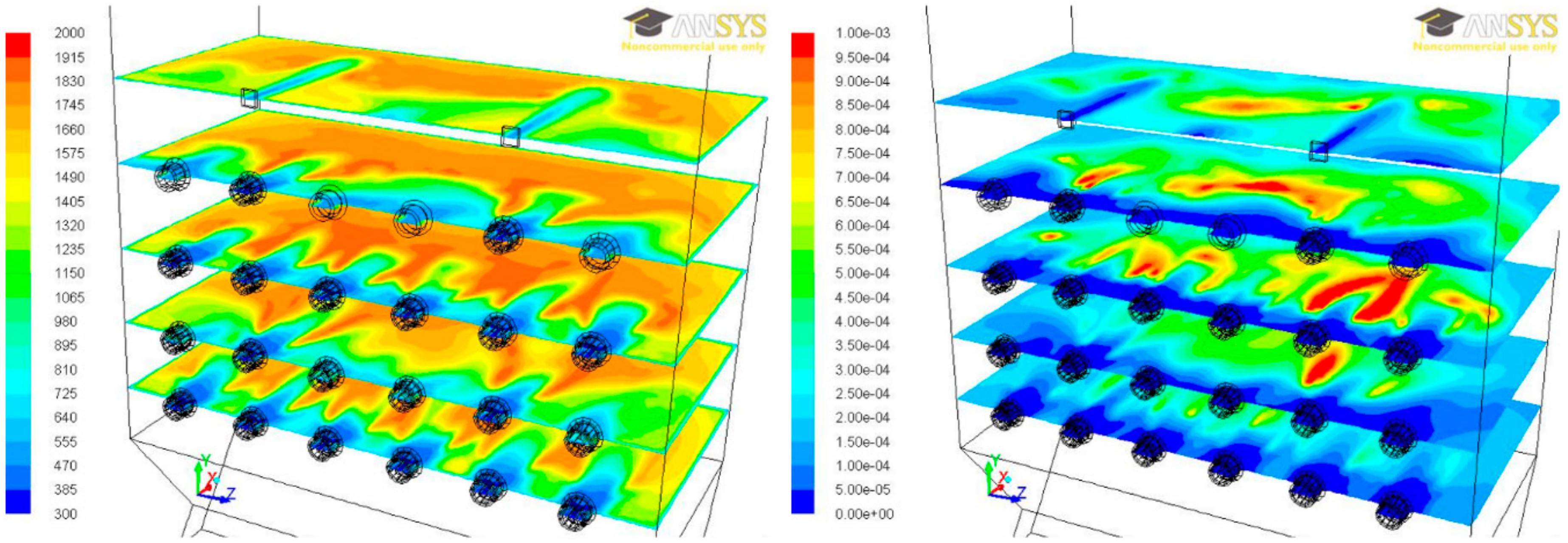

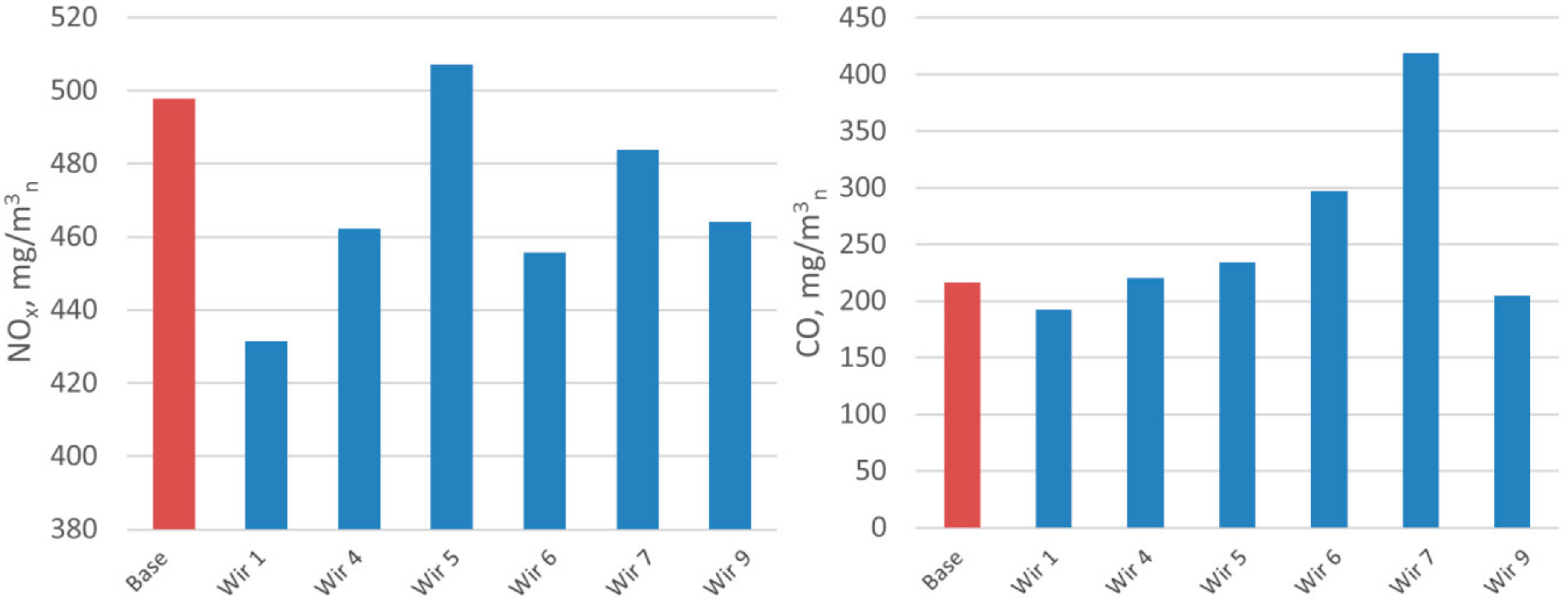
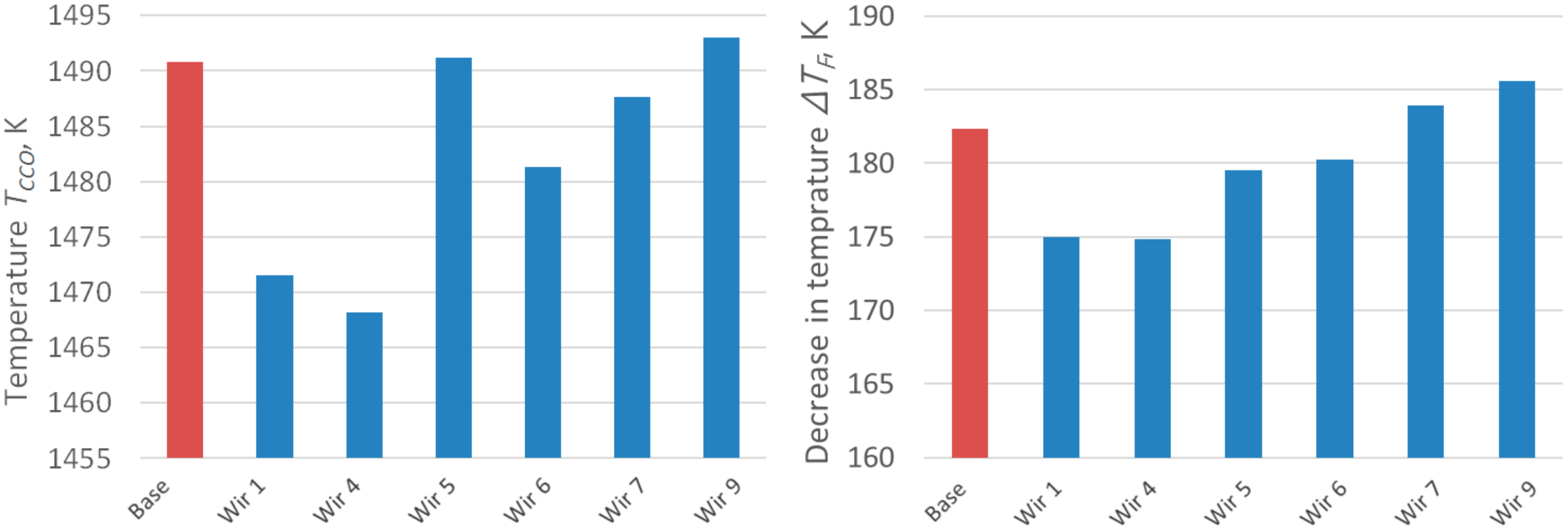
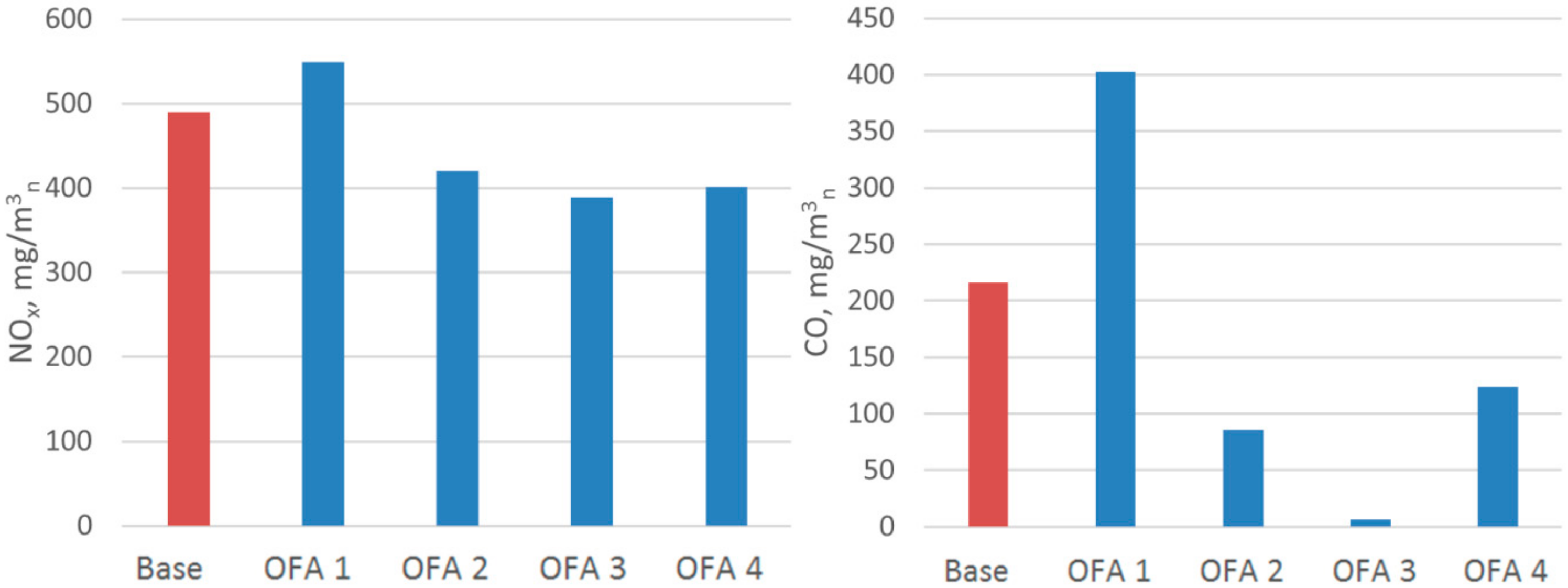

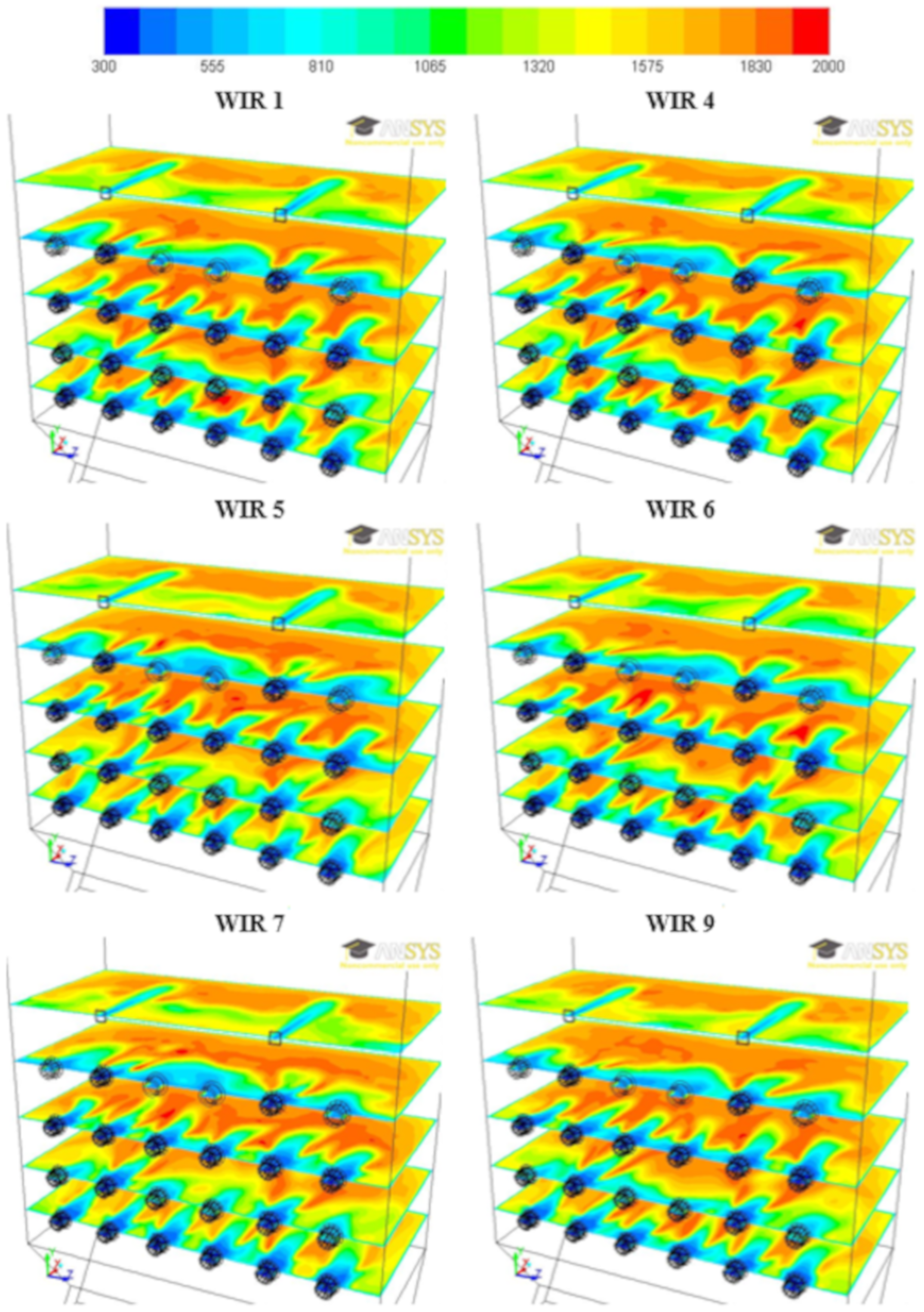
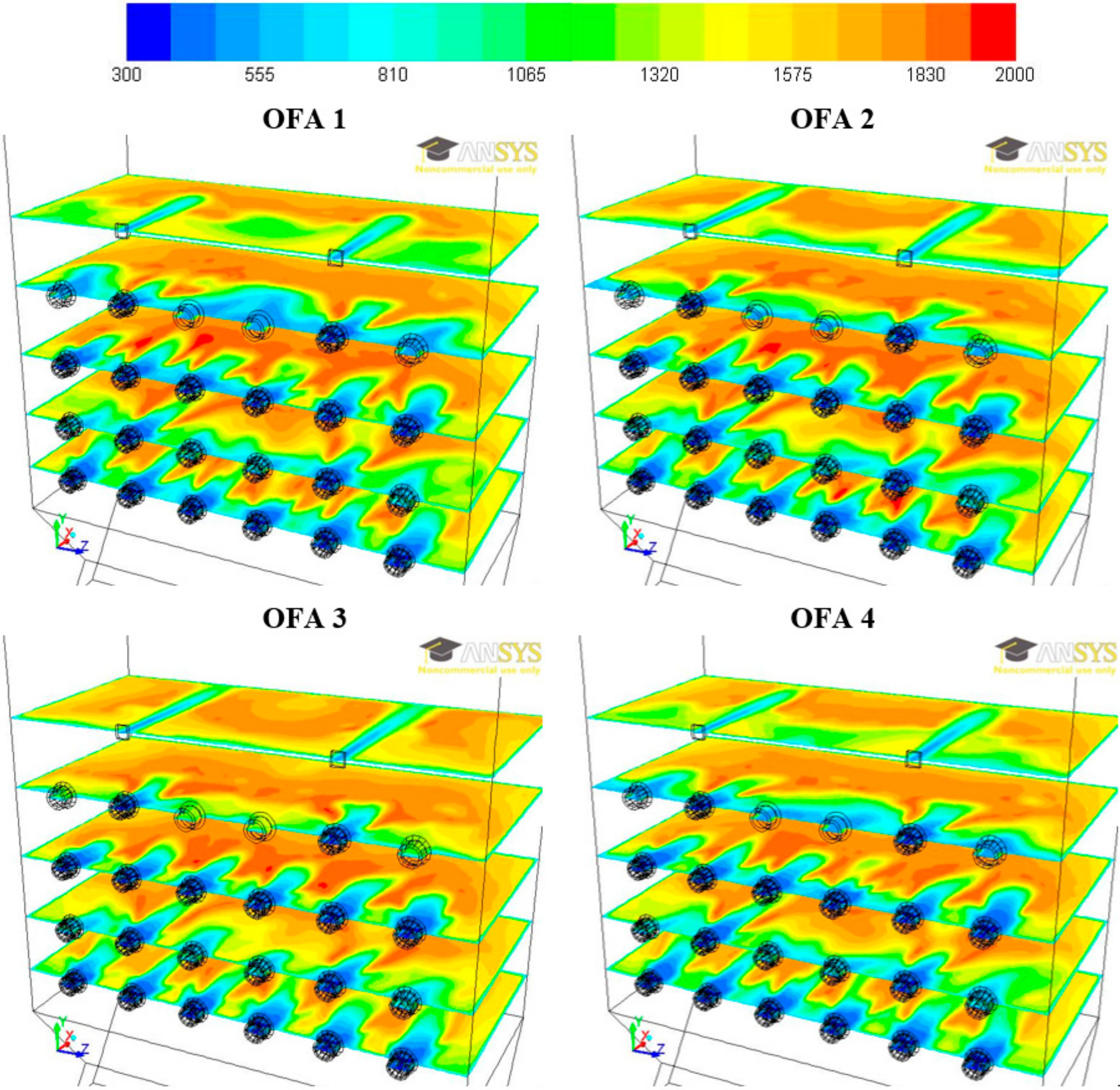

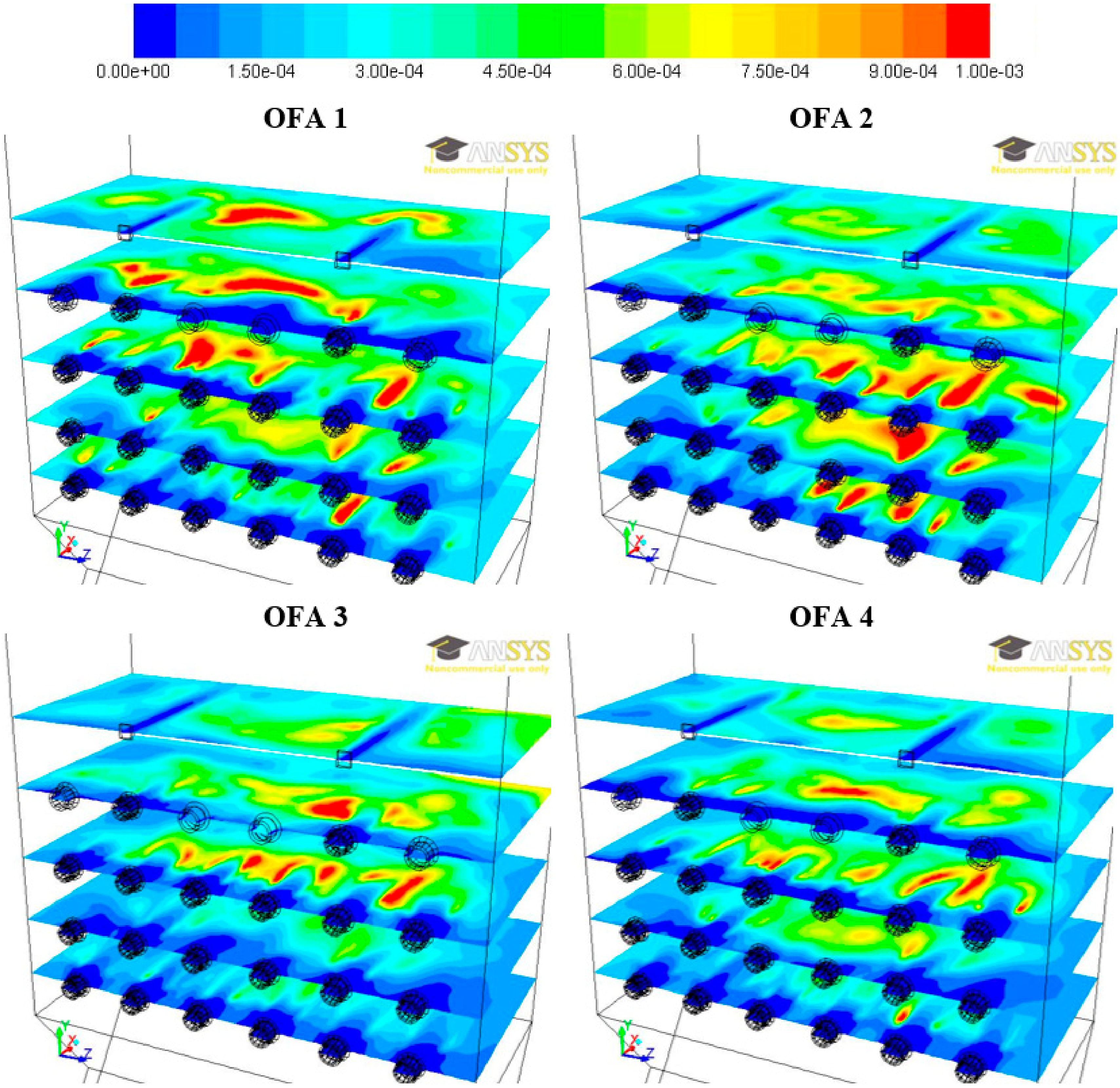
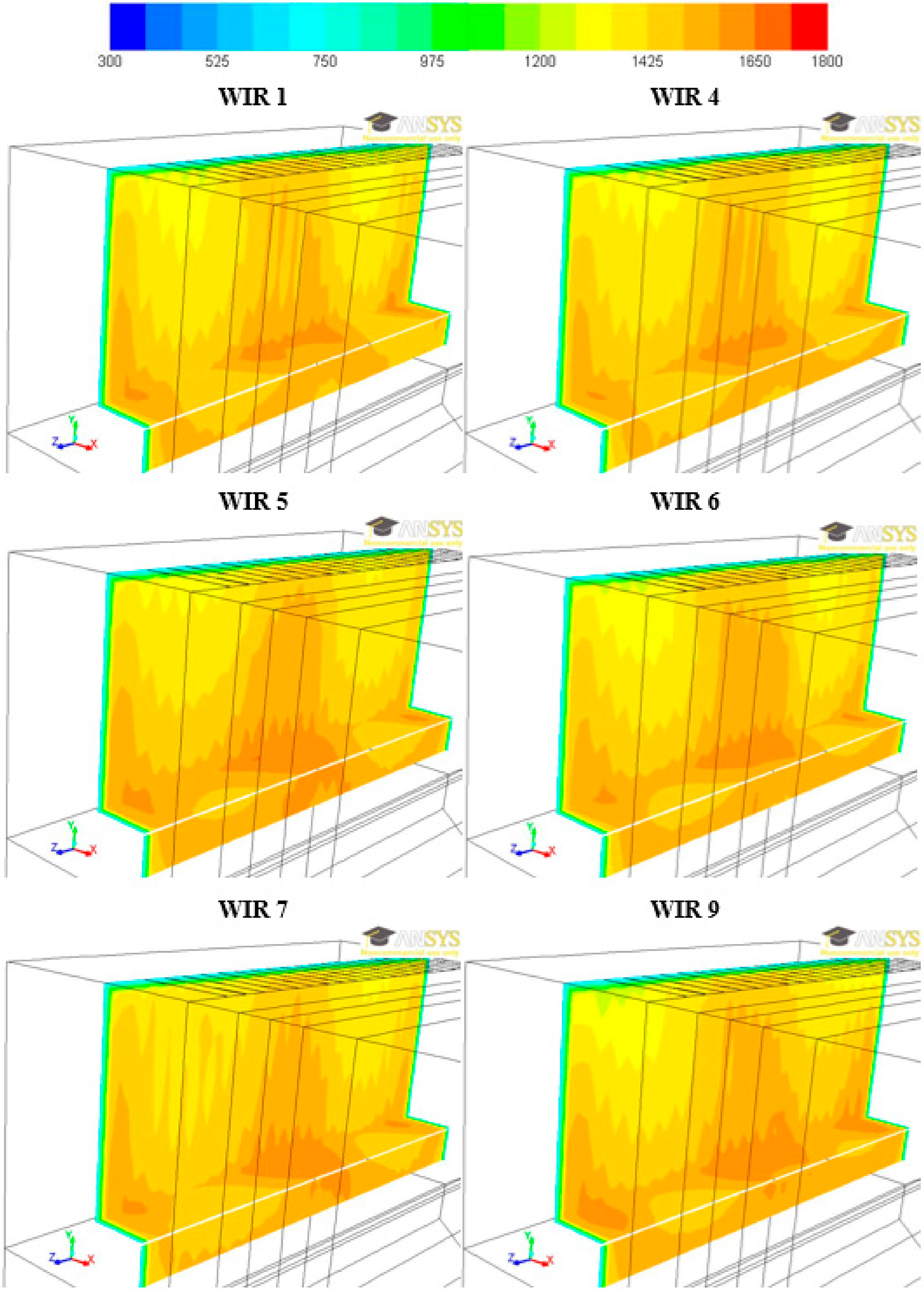

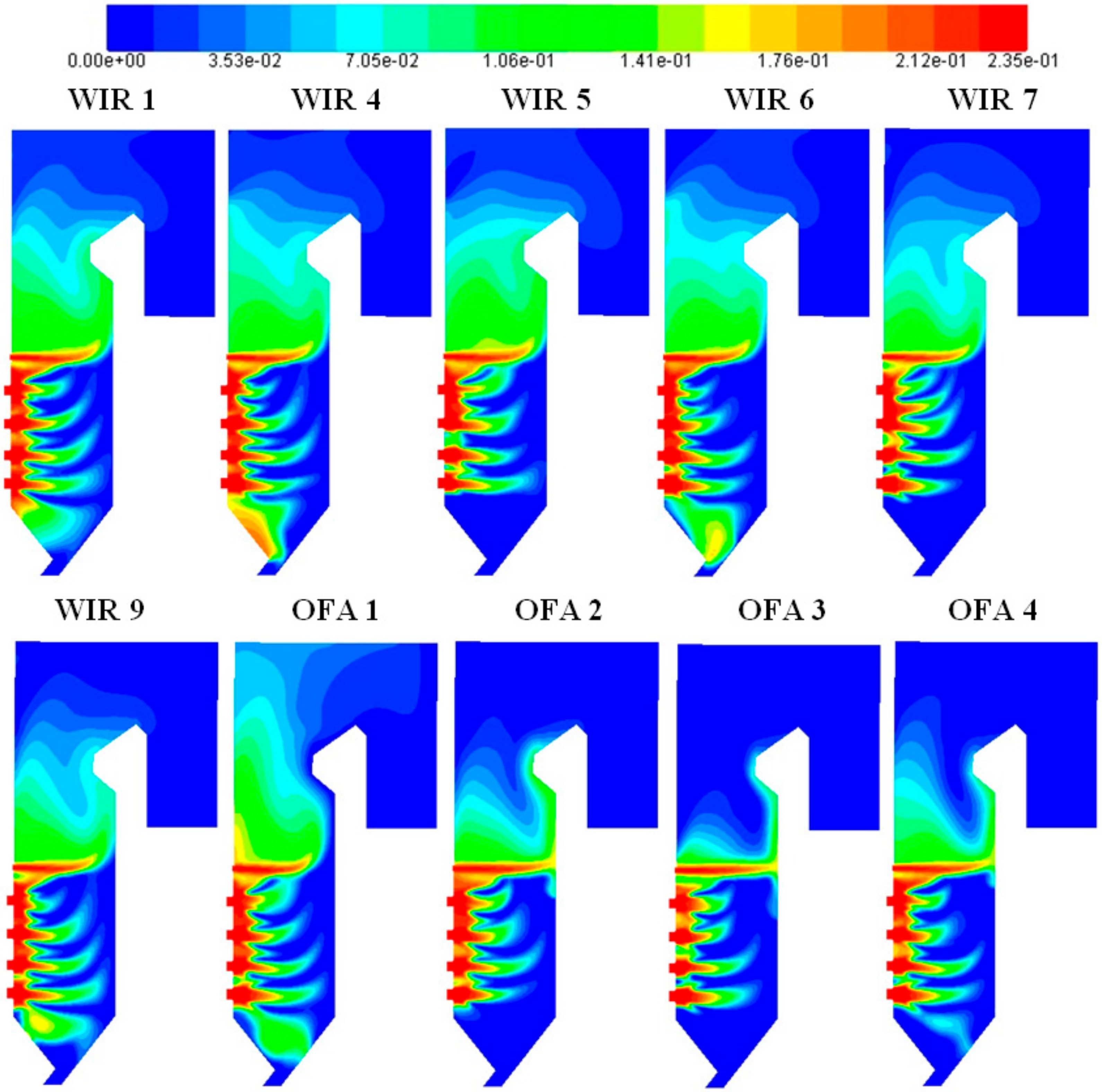

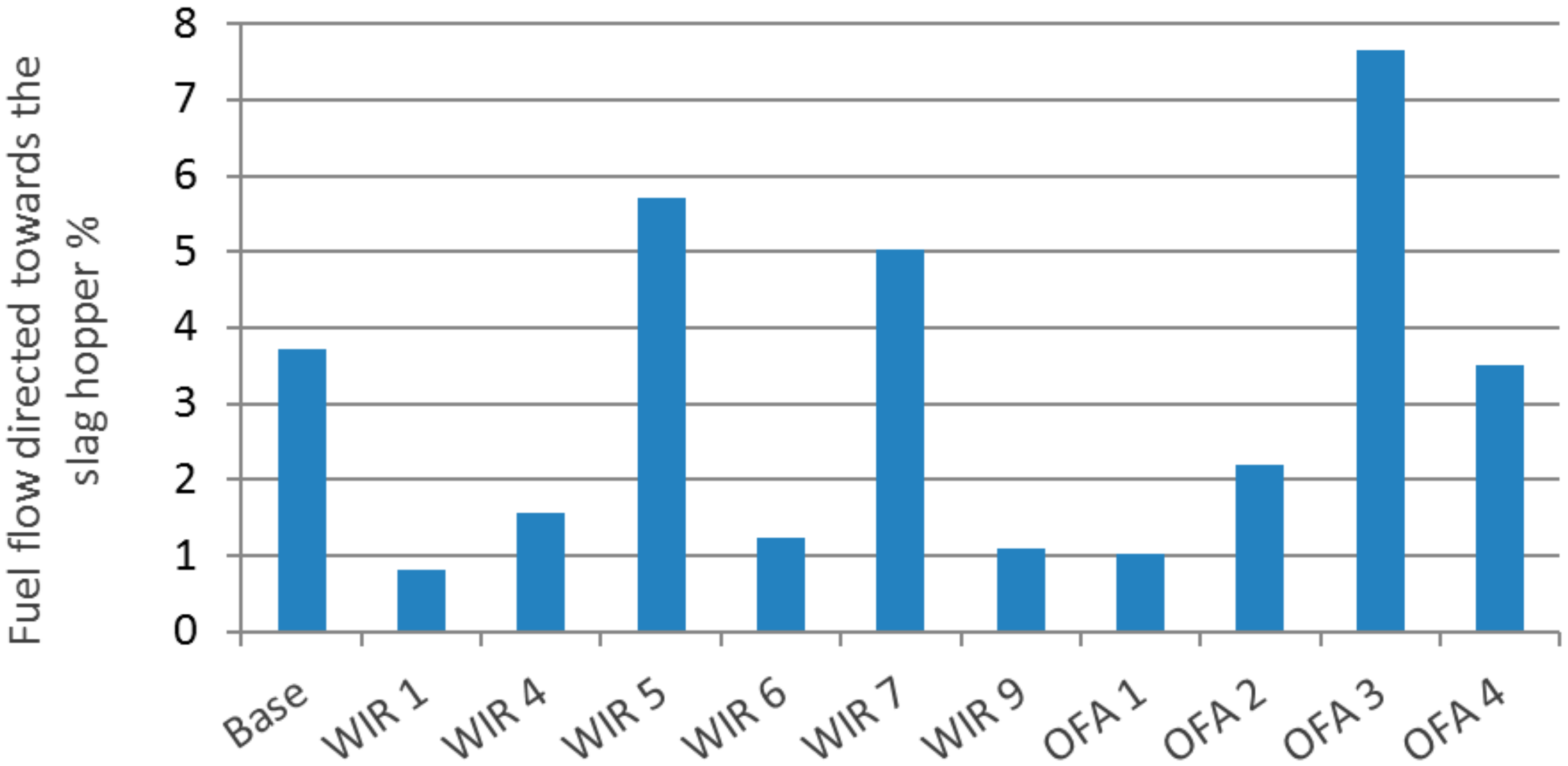
| Data | Unit | Value |
|---|---|---|
| Operating pressure | MPa | 15.1 |
| Live steam mass flow rate | t/h | 650 |
| Live steam pressure | MPa | 13.6 |
| Live steam temperature | °C | 540 |
| Reheated steam mass flow rate | t/h | 565 |
| Reheated steam pressure | MPa | 2.43 |
| Reheated steam temperature | °C | 540 |
| Steam pressure at the reheated inlet | MPa | 2.62 |
| Steam temperature at the reheated inlet | °C | 330 |
| Feed water pressure | MPa | 15.4 |
| Feed water temperature | °C | 242 |
| Data | Unit | Mill | ||||
|---|---|---|---|---|---|---|
| A | B | C | D | E | ||
| Coal Mass Flow | kg/s | 6.90 | 6.90 | 6.90 | 6.90 | - |
| Core air mass flow | kg/s | 0.94 | 0.94 | 0.94 | 0.94 | - |
| Primary air mass flow | kg/s | 16.83 | 16.83 | 16.83 | 16.83 | - |
| Secondary air mass flow II | kg/s | 6.30 | 6.30 | 6.30 | 6.30 | 2.52 |
| Secondary air mass flow III | kg/s | 18.90 | 18.90 | 18.90 | 18.90 | 7.56 |
| OFA_l air mass flow to OFA | kg/s | 35.59 | ||||
| OFA_u air mass flow to OFA | kg/s | 11.02 | ||||
| Mixture temperature | °C/K | 100/373 | ||||
| Secondary air temperature | °C/K | 280/553 | ||||
| Data | Value | Unit |
|---|---|---|
| Residue on 88 (90) µm sieve | % | 31.2 |
| Residue on 150 µm sieve | % | 12.9 |
| Residue on 200 µm sieve | % | 3.6 |
| The average diameter | µm | 78.1 |
| Polydispersity number | - | 1.28 |
| Data | Value | Unit |
|---|---|---|
| Calorific value | 20,800 | kJ/kg |
| Ash content | 24.8 | % |
| Moisture content | 10.9 | % |
| Sulfur | 0.9 | % |
| Carbon | 54.3 | % |
| Hydrogen | 3.3 | % |
| Oxygen | 4.9 | % |
| Nitrogen | 0.9 | % |
| Combustion Model of Volatile | Reaction k1 | Reaction k2 |
|---|---|---|
| A = 2.119 × 1011 E = 2.027 × 108 J/kmol | A = 2.239 × 1012 E = 1.92 × 108 J/kmol | |
| For the coal particle | ||
| Devolatilization | Single-rate model A = 382,000 E = 6.7 × 107 J/kmol | |
| Combustion of char | Kinetic-diffusion model C1 = 5 × 10−11, C2 = 0.1 EA = 7.2 × 107 J/kmol | |
| Data | OFA 1 | OFA 2 | OFA 3 | OFA 4 |
|---|---|---|---|---|
| Air mass flow III, kg/s | 18.9 | 18.9 | 18.9 | 17.01 |
| Air mass flow to OFA_l, kg/s | 38.3 | 26.7 | 17.8 | 35.6 |
| Air mass flow to OFA_u, kg/s | 8.3 | 19.9 | 28.8 | 18.6 |
| Case | O2, % | TCCO, K | TPSO, K | HAww, MWth | HAps, MWth | HA5th, MWth | HA2nd, MWth | HAchs, MWth |
|---|---|---|---|---|---|---|---|---|
| 0D model | 2.57 | 1482 | 1292 | 265 | 47.7 | 25.2 | 88.4 | 76.9 |
| Base | 1.96 | 1489 | 1306 | 285 | 53.5 | 31.3 | 85.7 | 82.9 |
| Case | O2, % | CO, mg/m3n | NOx, mg/m3n | TCCO, K | TPSO, K | TOUT, K |
|---|---|---|---|---|---|---|
| Base | 1.76 | 216.4 | 489.5 | 1490.8 | 1306.5 | 600.2 |
| WIR 1 | 1.93 | 192.8 | 431.5 | 1471.6 | 1296.6 | 596.2 |
| WIR 2 | 2.17 | 367 | 516.5 | 1479.1 | 1302.2 | 601.2 |
| WIR 3 | 1.99 | 264.8 | 571.2 | 1482.1 | 1300.4 | 605.8 |
| WIR 4 | 1.91 | 220.6 | 462.3 | 1468.2 | 1293.4 | 595.9 |
| WIR 5 | 1.87 | 234 | 507 | 1491.2 | 1311.7 | 602.4 |
| WIR 6 | 1.73 | 297.2 | 455.7 | 1481.3 | 1301.1 | 597.1 |
| WIR 7 | 1.95 | 418.8 | 483.7 | 1487.6 | 1303.7 | 596 |
| WIR 8 | 1.9 | 795 | 531.3 | 1486.3 | 1302.9 | 594.8 |
| WIR 9 | 1.54 | 204.9 | 464 | 1493 | 1307.4 | 594 |
| OFA 1 | 2.41 | 402.9 | 549 | 1472.9 | 1299.9 | 620.7 |
| OFA 2 | 1.25 | 85.9 | 420.1 | 1544.6 | 1343.5 | 600.3 |
| OFA 3 | 1.21 | 6.6 | 388.7 | 1533.3 | 1324.2 | 572.5 |
| OFA 4 | 1.52 | 123.6 | 401.5 | 1534.5 | 1338.8 | 604.3 |
© 2020 by the author. Licensee MDPI, Basel, Switzerland. This article is an open access article distributed under the terms and conditions of the Creative Commons Attribution (CC BY) license (http://creativecommons.org/licenses/by/4.0/).
Share and Cite
Hernik, B. Numerical Research of the Modification of the Combustion System in the OP 650 Boiler. Energies 2020, 13, 725. https://doi.org/10.3390/en13030725
Hernik B. Numerical Research of the Modification of the Combustion System in the OP 650 Boiler. Energies. 2020; 13(3):725. https://doi.org/10.3390/en13030725
Chicago/Turabian StyleHernik, Bartłomiej. 2020. "Numerical Research of the Modification of the Combustion System in the OP 650 Boiler" Energies 13, no. 3: 725. https://doi.org/10.3390/en13030725





